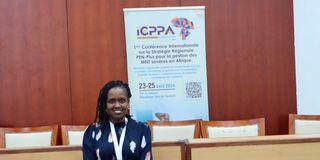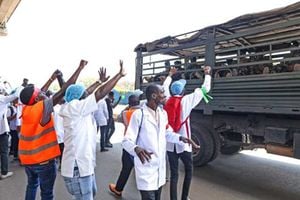Living a full life after four heart surgeries

Ruth Ngwaro, congenital heart disease patient who has undergone four surgeries, during the interview at the First International Conference on the PEN — Plus Regional Strategy to Address Severe NCDs in Africa — in Dar es Salaam, Tanzania.
What you need to know:
- Doctors had to do more evaluation and that is when they discovered that I had four holes in the heart.
- I ended up having two surgeries in a span of two weeks to correct the problem.
"I was born with a large hole between the pumping chambers of my heart and had severe leakage in one of my valves. The two problems caused enlargement of my heart and elevation of pressure in my blood vessels.
My parents discovered that I had the problem when I was only three months old. I was unable to breastfeed and doctors would mostly treat me for pneumonia. Thereafter, they confirmed that I had a congenital heart condition and I needed surgery to correct it.
From this point, the condition started being managed with the aim of ensuring that I was living a good quality life. At the time, there was no surgery available for my condition in Kenya.
In 1993 at the age of four, I was lucky to be selected from among hundreds of children born with cardiac problems, through the Heart to Heart programme from the United States. This initiative was helping children from developing countries, who had medical problems that required surgeries, yet their parents were too poor to pay for it.
I was airlifted to the University of Maryland Medical centre in the US, where I received a free open-heart surgery. The operation took about three hours. I spent three days in ICU before I was moved to a private room. However, I did not recover well. I experienced overwhelming symptoms. For instance, I couldn’t walk. I was always tired and my fingers and lips turned blue.
Doctors had to do more evaluation and that is when they discovered that I had four holes in the heart. I ended up having two surgeries in a span of two weeks to correct the problem.
After that, I recuperated well and came back to Kenya, where I was able to catch up a little bit with other children and even go to school.
That was not the end of my health issues. During my operation in the US, doctors could not repair my mitral valve, which was leaking, because I was too young. They were supposed to replace it with an artificial one, but then they realised that if they went ahead and did it, I would have required another operation later in life to change it. So the only option was to manage the valve issue with medication. This went on until 2001, when the symptoms I had experienced earlier on in life came back. I was mostly in pain and could not do normal activities. I could experience excruciating pain on my left side of the heart and had episodes of fatigue. I could barely walk a long distance without resting, and even walking to school was a problem.
I was taken back to my cardiologist and after some tests, they discovered that my aortic valve had a growth, that was blocking the flow of blood to the heart. My mitral valve was still leaking. At this time, it was difficult to get anybody willing to do the surgery not only in Kenya, but also abroad. My parents tried to search for other options as far as India, but the feedback was the same. It was just too complicated.
My mother, who was working with the Heart to Heart Foundation, approached a heart surgeon here in Kenya who offered to help upon hearing about my condition.
In 2001, I had another heart surgery here in the country, where they removed the growth in the aortic valve and replaced the mitral valve with an artificial one.
Blood clot
After that, the condition was still managed and I had a lot of hospital visits and major tests to monitor how frequently my blood clotted. This was important because with the artificial valve, the blood cannot be too thick as it can clot. To manage this, I was also put on blood thinners so as to enable the valve to function optimally.
I continued with my recovery journey. In 2019, I relocated to Boston in the US. A few months later, I went for a normal routine check-up. I had just arrived in the US and as is their routine, you have to go through a comprehensive medical assessment to be integrated into their healthcare system.
After examination, they discovered my condition and sent me to a cardiologist for major heart tests.
Doctors discovered that I had something called atrial fibrillation, which was being managed by medication. I was immediately referred to Boston Children's Hospital. They had to find out the history of my condition and thereafter the doctors recommended another heart surgery to help me function better.
But after the surgery, I went into something called complete heart block. This is an abnormal heart rhythm resulting from a defect in the cardiac conduction system, leading to complete dissociation of the atria and ventricles. I was given a pacemaker, which helps in the communication between the upper chamber and the lower chamber of the heart.
The doctors also replaced the valve that I had since 2001 with a modern one. Unlike the new one, the previous one used to click like a watch, but this one was less noisy. They also gave me a bigger size because they were worried that I would outgrow it.
My recovery after surgery was smooth but six months after the procedure, I started getting arrhythmia, also known as irregular heartbeats. I would feel weak and dizzy, experience shortness of breath and chest pains.
Doctors had to frequently perform a procedure called ablation, which helps break electrical signals that cause irregular heartbeats.
This became a norm for three years, and I would undergo the procedure after every three months.
This was until last year March when the doctors decided to just make a full heart ablation, a treatment for irregular heart rhythms.
Since then, my health has been amazing and I would say I am functioning well above the baseline that I had before the surgery.
But then I have always been on medication. I can't remember the medication I was taking when I was younger. It was only after my surgery in 2001 that I started tracking the amount of prescription drugs I had and one of them was blood thinners.
The worst period was after the 2020 surgery, when I found myself taking up to eight different drugs to manage the situation. Right now we are trying to wind down on the number of medications I am using, though there are some which I can’t just stop taking, for instance, the blood thinners, because I have an artificial valve.
Socially, the condition has had an impact on my life, especially as a child. Growing up, most children were afraid of associating or playing with me because sometimes I could faint.
But the biggest impact it has had on me socially is being around people who either did not understand what it means to have a heart condition, or simply they didn’t care, and this came with a lot of stigma.
In school, I remember there was this teacher who would punish my sister and I whenever we got late for school. This was traumatising for me because I felt that my sister was suffering because of my condition.
Sadly, there is a lack of awareness within communities, especially in developed countries, Kenya being one of them.
There were times when I was not able to walk because of the progression of the disease, and so my mother could be forced to carry me, keeping in mind that I was a big girl. So sometimes we could meet with people on the road and they would be like ‘hey, why are you carrying a big girl’.
The disease also drained my family financially.
For instance, a surgery costs between Sh2 million to Sh3 million, and so at one point my parents needed to raise this money. We did like three fund-raisers and we never even raised Sh1 million.
And this is what makes you comprehend the importance of having quality in health provision, meaning that everybody is given an equal chance to a health insurance that is able to cover these conditions.
And that is why I have been very vocal when it comes to advocacy for the rights of people living with heart conditions. I am the co-founder of Kenyan Mended Heart Patients Association, which advocates for people living with congenital heart disease. It is more of a support group for people living with heart conditions, as well as parents of children with similar health issues. I also advocate for policy change, access, early diagnosis among other issues.
I work with NCDI poverty network as a member of voices for PEN-Plus. Right now the programme has only two heart clinics countrywide; one in Vihiga and another one in Isiolo, and so if you suspect your child has any heart condition, you can go to these clinics. If they have had heart surgeries, they can go there for follow-up because the medical personnel in these health centres are trained to handle those cases.





